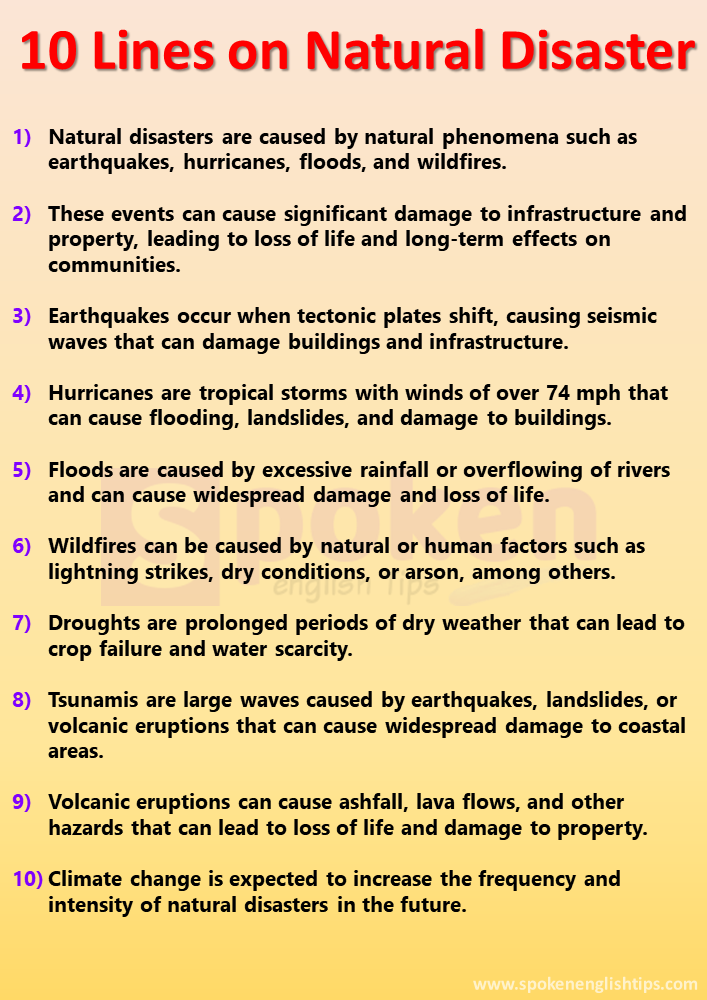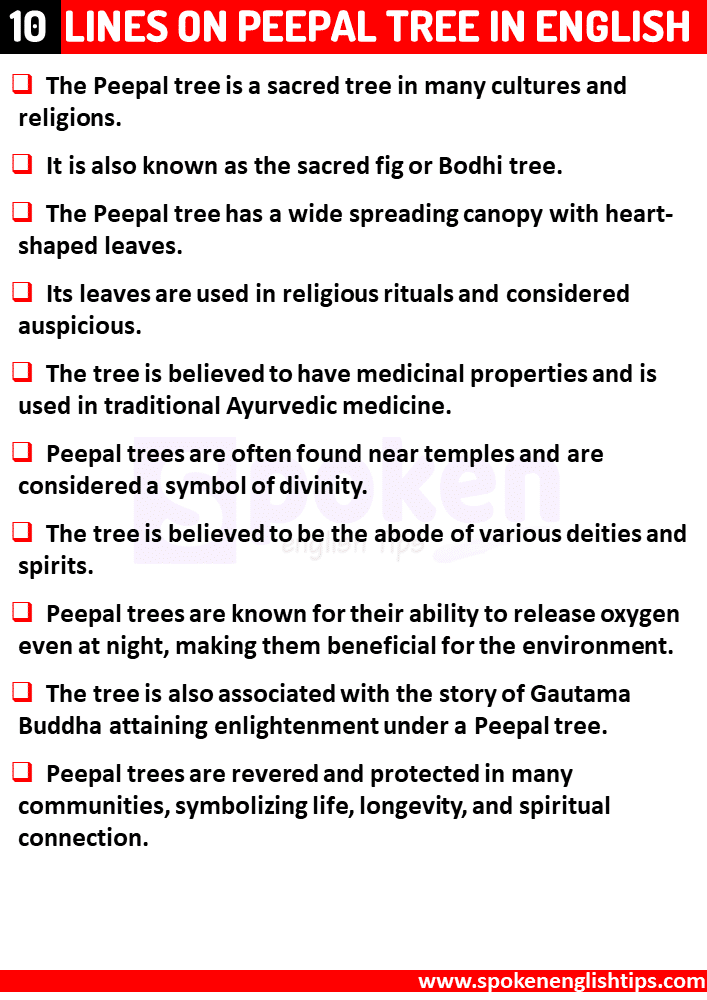Natural disasters can be devastating and can have long-term effects on individuals and communities. In this blog post, we will explore 10 lines on natural disasters, their causes, effects, and ways to prevent them.
Natural disasters are events caused by natural phenomena such as earthquakes, hurricanes, floods, and wildfires, among others. They can cause significant damage to property and infrastructure, loss of life, and long-term effects on individuals and communities. In this blog post, we will explore ten lines on natural disasters, their causes, effects, and ways to prevent them.
10 Lines On Natural Disaster:
Set 1
- Natural disasters are caused by natural phenomena such as earthquakes, hurricanes, floods, and wildfires.
- These events can cause significant damage to infrastructure and property, leading to loss of life and long-term effects on communities.
- Earthquakes occur when tectonic plates shift, causing seismic waves that can damage buildings and infrastructure.
- Hurricanes are tropical storms with winds of over 74 mph that can cause flooding, landslides, and damage to buildings.
- Floods are caused by excessive rainfall or overflowing of rivers and can cause widespread damage and loss of life.
- Wildfires can be caused by natural or human factors such as lightning strikes, dry conditions, or arson, among others.
- Droughts are prolonged periods of dry weather that can lead to crop failure and water scarcity.
- Tsunamis are large waves caused by earthquakes, landslides, or volcanic eruptions that can cause widespread damage to coastal areas.
- Volcanic eruptions can cause ashfall, lava flows, and other hazards that can lead to loss of life and damage to property.
- Climate change is expected to increase the frequency and intensity of natural disasters in the future.
Set 2
- Natural disasters are events caused by natural phenomena such as earthquakes, hurricanes, floods, and droughts.
- These events can cause significant damage to infrastructure, homes, and the environment.
- Natural disasters can also result in loss of life, injuries, and displacement of people.
- Earthquakes are sudden and violent movements of the earth’s surface that can cause the destruction of buildings and infrastructure.
- Hurricanes are powerful storms that bring high winds, heavy rain, and storm surges, leading to flooding and destruction.
- Floods occur when there is excessive rainfall or a rise in water levels, leading to damage to homes, buildings, and infrastructure.
- Droughts are periods of extended dry weather that can cause crops to fail and lead to food shortages.
- Tsunamis are large ocean waves caused by earthquakes or volcanic eruptions that can cause significant damage to coastal areas.
- Wildfires are uncontrollable fires that can destroy large areas of forests, homes, and other structures.
- It is important to be prepared for natural disasters by having emergency supplies and evacuation plans in place.
5 Lines On Natural Disaster:
- Natural disasters are events caused by natural forces such as earthquakes, floods, hurricanes, and wildfires.
- These events can cause widespread destruction, loss of life, and economic damage.
- Earthquakes can cause buildings and infrastructure to collapse, while floods can lead to homes and businesses being destroyed.
- Hurricanes and cyclones can bring strong winds and heavy rain, causing flooding, landslides, and mudslides.
- Wildfires can burn through vast areas of land, destroying forests, homes, and wildlife habitats.
20 Lines On Natural Disaster:
- Landslides are sudden movements of soil and rock down a slope that can damage buildings and infrastructure.
- Tornadoes are rotating columns of air that can cause extensive damage to buildings and homes.
- Volcanic eruptions can release lava, ash, and toxic gases that can damage infrastructure and harm people.
- Heatwaves are extended periods of hot weather that can lead to dehydration, heat exhaustion, and heatstroke.
- Cyclones are powerful storms that form over the ocean and can cause flooding, high winds, and storm surges.
- Hailstorms can cause damage to buildings, crops, and vehicles due to the large-sized hailstones.
- Snowstorms can cause significant disruption to transportation and communication systems and can also result in power outages.
- Sinkholes are sudden collapses of the ground that can damage buildings and infrastructure.
- Avalanche is a sudden flow of snow that can cause damage to structures and can also lead to loss of life.
- Extreme cold weather can cause frostbite, hypothermia, and other cold-related health problems.
- Mudslides are fast-moving flows of mud that can damage infrastructure and homes.
- Thunderstorms can cause lightning strikes, hail, high winds, and heavy rain that can damage homes and infrastructure.
- Storm surges are sudden rises in sea level that can cause flooding in coastal areas.
- Tidal waves are large ocean waves that can cause extensive damage to coastal areas and infrastructure.
- Dust storms can reduce visibility and cause respiratory problems for people living in affected areas.
- Earthquakes can trigger tsunamis that can cause extensive damage to coastal areas.
- Biological disasters such as pandemics and epidemics can lead to loss of life and have a significant impact on the economy and society.
- Solar flares can cause disruptions to satellite communication and power grids.
- Insect infestations such as locust swarms can cause damage to crops and food supplies.
- Animal attacks such as shark attacks and snake bites can cause harm to people and animals.
Causes and Effects of Natural Disasters:
Natural disasters are caused by natural phenomena, but human activities can also exacerbate their effects. For example, deforestation can increase the likelihood of landslides and flooding, while urbanization can lead to greater damage from hurricanes and other events. The effects of natural disasters can be devastating, leading to loss of life, displacement, and long-term effects on individuals and communities.
Preventing Natural Disasters:
While natural disasters cannot be prevented entirely, there are measures that individuals and communities can take to reduce their impact. These include early warning systems, emergency preparedness, and mitigation measures such as building codes and land-use planning. Additionally, reducing greenhouse gas emissions can help mitigate the effects of climate change and reduce the likelihood of extreme weather events.

Conclusion:
Natural disasters can have devastating effects on individuals and communities. By understanding their causes, effects, and ways to prevent them, we can reduce their impact and build more resilient communities. As we continue to face the challenges of climate change and other natural phenomena, it is essential to work together to mitigate their effects and prepare for the future.
Read Also:
- 10 Entrepreneur Sentences
- 10 Fascinating Facts about Holi Festival for Students
- 10 line poems on poetry out loud – Short poetry out loud
- 10 Lines On Aeroplane
- 10 Lines On Apple Tree
- 10 Lines On Banana Tree In English
- 10 Lines On Basant Panchami In English
- 10 lines on Buland Darwaza for Students and Children in English
- 10 lines on Charles Babbage– Short Essay On Robot
- 10 Lines On Charminar
- 10 Lines On Childhood Memories
- 10 Lines On Computer For Class 3
- 10 Lines On Crow in English
- 10 Lines On Diwali In English For Class 5
- 10 Lines On Durga Puja In English For Class 2
- 10 Lines On Dussehra For Class 3


